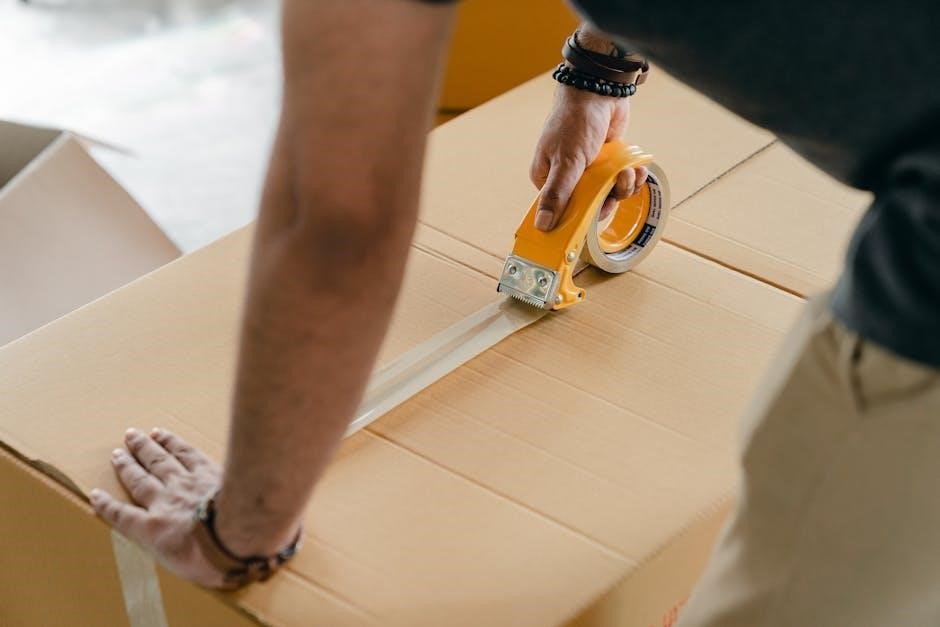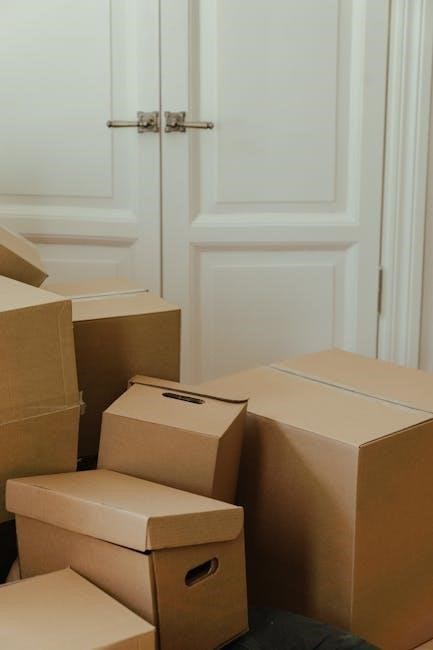
checklist for moving house pdf
A moving house checklist is a strategic tool to manage relocation efficiently. Available as a printable PDF, it outlines tasks from 8 weeks prior to post-move activities, ensuring a seamless transition with organized timelines, labeling guides, and expert tips for a stress-free relocation experience.
Why a Moving Checklist is Essential
A moving checklist is indispensable for ensuring a smooth and stress-free relocation. It helps organize tasks, from decluttering to packing, and provides a clear timeline for completion. By breaking down the process into manageable steps, it prevents overwhelmed feelings and ensures no crucial details are overlooked. Customizable templates, such as printable PDFs, allow you to tailor the checklist to your specific needs, covering everything from labeling boxes to updating your address. This structured approach not only saves time but also reduces anxiety, ensuring every aspect of your move is accounted for. Whether you’re moving locally or long-distance, a checklist acts as your ultimate guide, keeping you on track and guaranteeing a seamless transition to your new home.
What to Expect in This Article
This article provides a comprehensive guide to creating and using a moving house checklist. You’ll find detailed timelines, room-by-room packing strategies, and essential legal considerations. Discover how to reduce stress and ensure nothing is forgotten. Explore sections on labeling boxes, updating addresses, and post-move tasks. Practical tips and downloadable PDF templates are included to streamline your relocation process. Whether you’re planning weeks ahead or need last-minute advice, this resource offers a structured approach to make your move efficient and stress-free. From preparation to execution, this guide covers every aspect, ensuring a smooth transition to your new home with customizable tools and expert advice.

Importance of a Moving Checklist

Importance of a Moving Checklist
A moving checklist is essential for reducing stress and ensuring nothing is forgotten. It serves as a strategic tool for organizing tasks, managing timelines, and facilitating a seamless relocation process.
Reducing Stress and Anxiety
A moving checklist significantly reduces stress and anxiety by providing a clear, structured plan for the entire relocation process. It helps break down tasks into manageable steps, ensuring no detail is overlooked. With a timeline-based approach, individuals can avoid last-minute rushes and stay in control. The checklist also serves as a visual reminder of progress, offering peace of mind. By organizing tasks such as packing, labeling, and notifying essential services, it minimizes feelings of overwhelm. Additionally, having a comprehensive guide reduces uncertainty, allowing individuals to focus on the excitement of their new home rather than the chaos of moving. Printable PDF templates and customizable options further enhance its effectiveness, making it a invaluable tool for a stress-free relocation experience.
Ensuring Nothing is Forgotten
A moving house checklist is designed to prevent oversights by systematically accounting for all tasks and items. It organizes responsibilities into categories like packing, notifications, and preparations, ensuring a thorough approach. Room-by-room inventories help track belongings, while detailed timelines address deadlines for address changes and utility setups. The checklist also includes reminders for often-overlooked tasks, such as defrosting appliances or transferring home services. By following a structured format, individuals can confidently ensure no step is missed, from labeling boxes to securing insurance for belongings. This comprehensive approach minimizes the risk of forgetting critical details, providing a reliable framework for a smooth and efficient relocation experience.

Timeline for Moving House
A moving house timeline typically starts 8 weeks before the move, covering tasks like decluttering, hiring movers, and packing. It structures key milestones up to moving day, ensuring efficiency.
8 Weeks Before Moving
Starting early is crucial for a smooth relocation. At 8 weeks before moving, begin by decluttering and organizing your belongings. Sort items to keep, donate, sell, or discard. Research and hire a reliable moving company or rent a moving truck. Create a moving binder to keep track of receipts, contracts, and important documents. Notify your bank, credit card company, and loan providers about your move. Update your address with the post office, utility providers, and subscription services. Measure furniture and doors to ensure a smooth move. Start packing non-essential items like seasonal decorations or off-season clothing. Label boxes clearly and categorize them by room. Take inventory of your belongings for insurance purposes. Review and finalize your moving plan to avoid last-minute chaos. Stay organized and focused to ensure a stress-free transition.
4 Weeks Before Moving
Four weeks before moving, focus on finalizing logistics and accelerating packing. Confirm moving details with your chosen company, including the date, time, and inventory list. Transfer utilities to your new address and schedule final readings at your current home. Pack non-essential items like books, seasonal clothing, and decorative items. Arrange for storage if needed. Defrost and clean appliances, and prepare electronics for safe transport. Notify your employer, school, or relevant institutions about your move. Ensure all financial and legal documents are in order. Review your moving binder and update any necessary information. Start familiarizing yourself with your new area, such as locating hospitals, schools, and grocery stores. Keep essentials like toiletries and medications separate for easy access. Stay on track with your checklist to maintain organization and reduce stress during this critical phase.
2 Weeks Before Moving
Two weeks before moving, intensify your efforts to ensure everything is ready. Complete packing all non-essential items, including seasonal decorations, off-season clothing, and books. Arrange for utility disconnections at your current home and schedule final cleanings. Transfer home services like internet and cable to your new address. Confirm parking and access details for the moving truck. Pack a “first night” box with essentials like toiletries, bedding, and a change of clothes for each person. Label keys and prepare a separate keyring for your old home. Defrost and clean appliances, ensuring they are dry before moving. Confirm moving details with your company, including the inventory list. Update your address with postal services, banks, and subscription providers. Review your moving binder and ensure all documents are organized. Stay focused and methodical to avoid last-minute chaos. This phase is critical for a smooth transition.
1 Week Before Moving
One week before moving, finalize all preparations to ensure a smooth transition. Complete any remaining packing, focusing on essentials like toiletries, medications, and a change of clothes. Label and organize boxes by room, ensuring fragile items are clearly marked. Confirm the moving truck arrival time and review the final inventory with your moving company. Pack a “first night” box with essentials for each household member. Defrost and clean refrigerators and freezers, leaving them dry. Notify neighbors and local services of your move. Double-check that all utilities are scheduled for disconnection and reconnection. Review your moving binder and ensure all documents are in order. Take final meter readings and document the condition of your old home. Stay calm and methodical, as the final countdown begins. This last week is crucial for ensuring everything is in place for moving day.

Packing Strategies
Start early, declutter, and organize items room-by-room. Use sturdy boxes, clear labels, and categorize contents. Keep essentials like toiletries and clothes accessible on moving day for convenience.
Decluttering and Organizing
Decluttering and organizing are crucial steps in the moving process. Start by evaluating each item to determine if it should be kept, donated, sold, or discarded. This ensures you only move what you truly need, saving time and resources. Organize items by category, such as clothing, books, and kitchenware, to make packing easier. Create a room-by-room inventory to keep track of your belongings. Use storage solutions like bins and labels to maintain order. A well-organized approach reduces chaos and makes unpacking more efficient. Remember, decluttering lightens the load, both physically and mentally, for a smoother transition to your new home.
Room-by-Room Packing Checklist
A room-by-room packing checklist helps ensure every area of your home is thoroughly prepared for the move. Start with the kitchen, packing non-essential items like seasonal dishes and small appliances first. In the bedroom, organize clothes by season and pack out-of-season items in labeled bins. For the living room, focus on decluttering books, DVDs, and decorative items, packing fragile items with care. Bathrooms require careful packing of toiletries and linens, while garages or storage areas may need heavy-duty boxes for tools and equipment. Create a checklist for each room, noting the number of boxes and specific contents. This methodical approach ensures nothing is overlooked and makes unpacking easier. Printable checklists are available online to tailor to your needs and keep track of progress.
Labeling and Categorizing Boxes
Labeling and categorizing boxes is crucial for an organized move. Clearly mark each box with its room destination, contents, and handling instructions (e.g., “Fragile” or “Heavy”). Use color-coded labels for different rooms to simplify unpacking. Categorize boxes by priority, such as “Essentials” for items needed immediately. List contents on the box and its top and sides for visibility. Consider creating a master list of boxes with corresponding numbers and descriptions. This system ensures boxes reach the right rooms and prevents loss or damage. Printable labels are widely available online, making the process easier. Proper labeling and categorization save time and reduce stress during unpacking. It also helps movers understand how to handle each box, ensuring a smoother transition to your new home;

Legal and Financial Considerations
Address updates, financial notifications, tax obligations, and insurance adjustments are essential legal and financial tasks to ensure a smooth transition. Complete all necessary forms to avoid delays and penalties, ensuring compliance.
Updating Your Address
Updating your address is a critical step in the moving process. Start by notifying the Post Office and completing a Change-of-Address form to ensure mail redirection. Inform banks, credit card companies, loan providers, and financial institutions to update your records. Don’t forget to notify your employer, healthcare providers, and insurance companies. Update your address with online services like Netflix, Amazon, and social media platforms. Notify friends, family, and subscriptions to avoid missed communications. Check with your local DMV to update your driver’s license and vehicle registration. Keep a list of all entities to contact, and track progress in your moving binder. This ensures seamless transitions and prevents service disruptions.

Notifying Banks and Financial Institutions
Notifying banks and financial institutions is a vital step in your moving process. Update your address with your bank to ensure seamless transactions and avoid disruptions. Inform credit card companies, loan providers, and investment firms to update your records. Request confirmation of address changes to maintain access to online banking and financial services. For mortgages or property loans, notify your lender to update records and avoid payment issues. Ensure credit card companies are aware of your move to prevent transaction restrictions. Keep a record of all notifications and follow up if necessary. This step ensures uninterrupted financial services and avoids potential issues with account access or payment processing. It’s also wise to notify your insurance provider to update policies for your new location.
Tax and Insurance Considerations
Tax and insurance considerations are crucial when moving house. Update your address with tax authorities to ensure accurate filings and potential refunds. If moving after filing taxes, complete Form 8822 to notify the IRS of your address change. Review insurance policies, including home and auto, to reflect your new location and adjust coverage as needed. Notify your insurance provider to update records and prevent gaps in coverage. If moving to a new state, check for changes in tax laws or insurance requirements. Ensure your new home is properly insured before moving in. Update any business or rental property insurance if applicable. Keep copies of updated policies for your records. Addressing tax and insurance details ensures compliance and financial protection during your transition.

Moving Day Checklist
Confirm moving details, ensure high-priority boxes are accessible, give clear instructions to removalists, and prepare essentials like a first-night box for a smooth transition.
Confirming Moving Details
Before moving day, verify the moving truck arrival time, crew details, and equipment with your removal company. Ensure all contact information is updated and accessible. Review the moving plan, including the route and estimated timeline, to avoid delays. Confirm parking arrangements for the moving truck at both locations to facilitate smooth loading and unloading. Recheck the inventory list with the moving company to ensure all items are accounted for. Address any last-minute changes or concerns to prevent misunderstandings. Having a clear communication channel with your movers will help resolve any unexpected issues promptly, ensuring a smooth and stress-free relocation experience.
Final Packing and Preparation
Complete all packing tasks, ensuring every item is securely placed in labeled boxes. Designate an “essentials box” with toiletries, medications, and a change of clothes for easy access. Double-check each room to confirm nothing is left behind. Review and finalize the packing inventory list to ensure all items are accounted for. Protect furniture and fragile items with padding or covers. Arrange boxes in a logical order, prioritizing heavy items at the bottom. Confirm that all doors and windows are secured, and keys are handed over if applicable. Ensure all utilities are metered and prepared for disconnection. Have a plan for last-minute cleaning and waste disposal. Finally, conduct a last walk-through to ensure everything is packed and ready for the movers.
Ensuring a Smooth Move
To ensure a smooth move, confirm all details with your moving company, including arrival times and contact information. Pack a “toolbox” with essentials like a screwdriver, pliers, and scissors for quick access. Keep valuable documents, such as insurance papers and identification, in a separate, easily accessible bag. Arrange parking for the moving truck and ensure a clear path for furniture removal. Designate a meeting point for keys and communicate clearly with the movers. Have refreshments and snacks on hand for the moving team. Double-check the weather forecast and prepare a backup plan if necessary; Finally, conduct a last-minute walkthrough to ensure all items are loaded and nothing is left behind. Proper preparation and clear communication will help minimize delays and ensure a seamless relocation experience.

Post-Move Checklist
After moving, organize your new space by unpacking essentials first. Check for damages, update services, and ensure all utilities are transferred. Review the move’s success and finalize any outstanding tasks to settle comfortably.
- Unpack and organize belongings room by room.
- Inspect for damages and report issues promptly.
- Update service providers with your new address.
Unpacking and Organizing
Begin by unpacking essentials like toiletries, bedding, and kitchenware to ensure immediate comfort. Designate a space for each item to maintain order. Assign tasks to family members to speed up the process. Check for damages and report any issues to the moving company. Organize belongings by category, such as seasonal items or tools, and label storage areas for easy access. Create a “first night” box with basics like towels, snacks, and chargers. Gradually unpack room by room, focusing on high-traffic areas first. Dispose of packing materials responsibly and update your address with service providers. Finally, take time to personalize your new space to make it feel like home.
Updating Services and Subscriptions
Notify utility providers, internet, and TV services of your address change to ensure uninterrupted service. Update your details with insurance companies, banks, and loan providers to maintain accurate records. Inform credit card companies and streaming platforms of your new address. Schedule final readings for utilities at your old home and set up accounts for your new location. Update your driver’s license and vehicle registration if moving to a new state. Notify healthcare providers and schools of your address change. Transfer home security systems and alarm services to your new address. Update your address with online shopping platforms and subscription boxes. Finally, complete a change-of-address form with the post office to forward mail to your new home.
Checking for Damages
After moving, inspect both your old and new homes for any damage. At your previous home, check walls, floors, and ceilings to ensure no damage was caused during the move. Document any pre-existing issues to avoid unnecessary charges. At your new home, inspect walls, floors, windows, and doors for scratches or breaks. Check appliances and fixtures to ensure they are in working condition. Take photos and notes of any damage found. If renting, notify your landlord or property manager immediately. For homeowners, document the condition of the property for future reference. Ensure all repairs are completed before finalizing the move. Keep a record of the condition of both homes for future use or when moving out. This step ensures accountability and protects you from potential disputes.

Additional Resources
Downloadable PDF templates and online tools provide additional resources to help organize and plan your move effectively, ensuring a seamless relocation experience.
Downloadable PDF Templates
Downloadable PDF templates provide a structured approach to organizing your move. These templates are professionally drafted to cover all aspects of relocation, from decluttering to post-move tasks. Many websites offer free, editable PDF checklists that can be customized to suit your needs. These templates often include timelines, room-by-room packing guides, and labeling tips to ensure nothing is overlooked. They are designed to be printable, allowing you to keep track of tasks physically. Features like checkboxes and categorized sections help maintain clarity and organization. With options to download and print, these PDF templates are a convenient resource for anyone planning a move. They also include spaces for notes and personalization, making them adaptable to different moving scenarios. By using a downloadable PDF template, you can streamline your moving process and reduce stress.
Online Tools for Moving Planning
Online tools for moving planning offer interactive solutions to streamline your relocation process. Many websites provide digital checklists, customizable templates, and organizational features to help you stay on track. These tools often include timelines, task management, and reminders to ensure no step is missed. Some platforms integrate with calendars, allowing you to set deadlines and share plans with family or movers. Additionally, online tools may offer features like budget trackers, inventory management, and even virtual room layouts to visualize your new space. They are accessible from any device, making it easy to update your checklist on the go. These tools also often include tips and resources for packing, labeling, and addressing common moving challenges; By leveraging online tools, you can create a personalized moving plan tailored to your specific needs, ensuring a smooth and efficient relocation experience.

